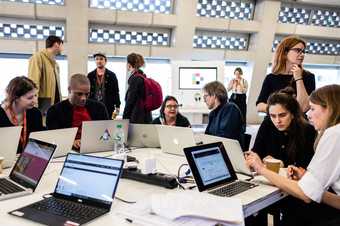UCL
Supervised by Dr Theano Moussouri, Institute of Archaeology, UCL, and Professor Pip Laurenson, Head of Collection Care Research, Tate
January 2019 –

Participants being introduced to Webrecorder at Lives of Net Art, organised as part of the Reshaping the Collectible project, Tate Modern, 4 April 2019
Photo © Hydar Dewachi
This AHRC-funded doctoral award is connected to the research project Reshaping the Collectible: When Artworks Live in the Museum and will problematize the proposition that greater transparency, and by turn greater inclusivity, can be achieved through making visible the currently invisible processes of museums. The research will focus on the work of the Conservation and Collection Care teams at Tate with the aim of developing new theoretical perspectives through which to examine the potential benefits and hazards (for museums and audiences) of bringing into public view these previously hidden processes.
It is through their holdings that museums build their identity, operate as educational institutions and, ultimately, justify their existence; collections are the locus around which the public and institution meet through exhibitions and displays. Yet the mechanisms of care and maintenance that preserve these collections, the processes and expertise that determine their acquisition and interpretation, and their physical storage systems, are often opaque and off limits to audiences. Finding a means to ‘open up’ the work of collection care and conservation – to make ‘visible’ – could have the potential to confront this power imbalance and address the boundaries between institution and audiences that perpetuate exclusionary museum practices.
This project will identify for the first time the processes and points of invisibility that are specific to the context of a contemporary art museum (as distinct from other types museums) and the stakes of ‘making visible’ in this type of institution. By considering the implications of making visible for both the institution and its visitors, and analysing these experiences in tandem, this research will provide a uniquely expansive exploration of what it means to make previously hidden processes public. The results of this research will provide valuable insight into the appetite amongst museum visitors for increased access to currently invisible museum processes; will examine the extent to which increased visibility might result in greater inclusivity; and subsequently assess the risks involved with implementing lasting changes to enable greater visibility.
